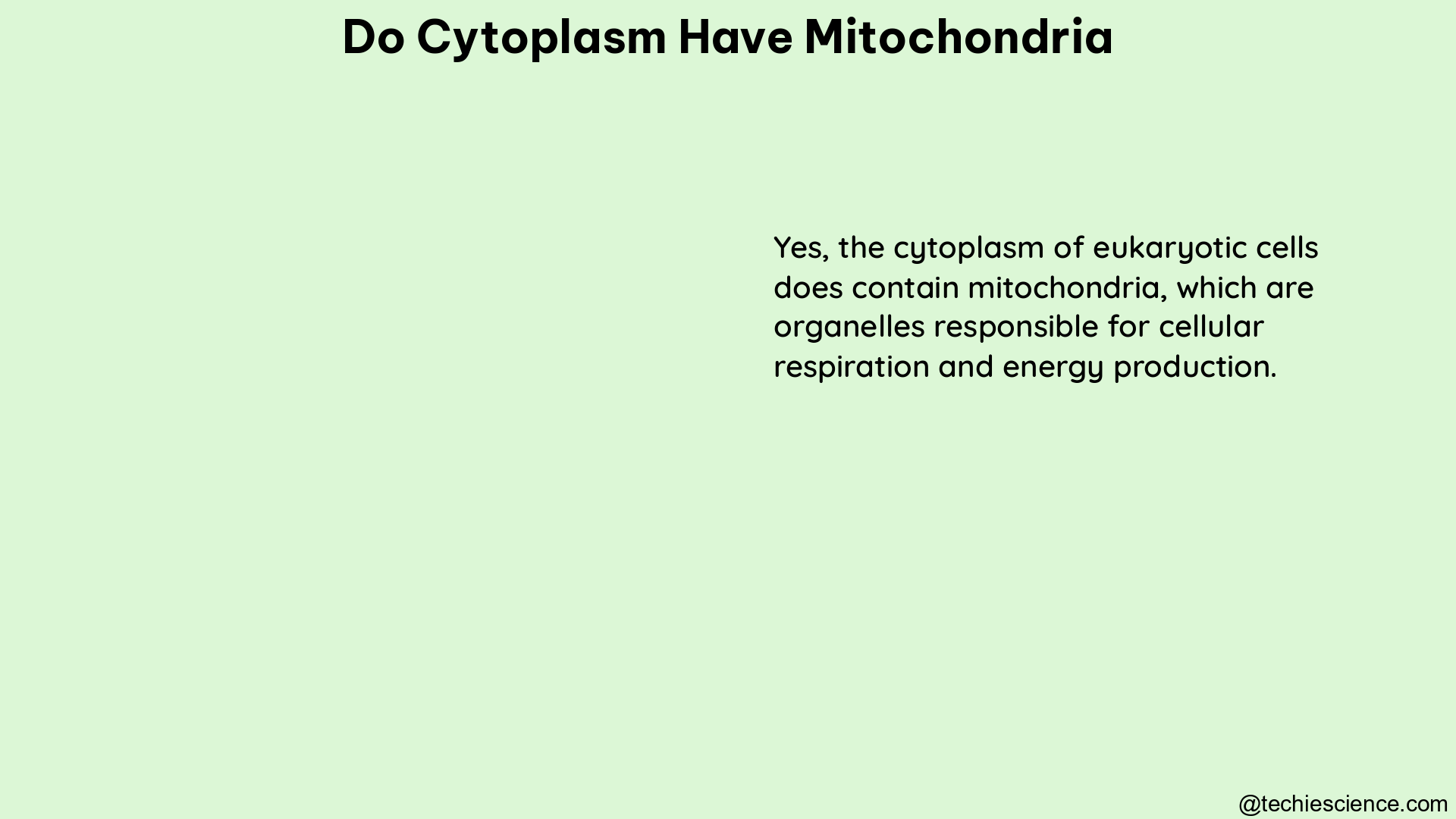Cytoplasm, the jelly-like substance that fills the interior of a cell, is the site of numerous essential cellular processes, including energy production, signaling, and metabolism. At the heart of these processes lies a crucial organelle – the mitochondrion. Mitochondria are often referred to as the “powerhouses” of the cell, as they are responsible for generating the majority of the cell’s energy in the form of adenosine triphosphate (ATP) through a process called oxidative phosphorylation.
The Presence of Mitochondria in Cytoplasm
The answer to the question “Do cytoplasm have mitochondria?” is a resounding yes. Mitochondria are ubiquitous organelles found in the cytoplasm of all eukaryotic cells, including plant, animal, and fungal cells. These double-membrane-bound organelles are distributed throughout the cytoplasm, often in a dynamic network that undergoes constant fission and fusion events.
Mitochondrial Abundance and Distribution
The number of mitochondria present in a cell can vary greatly depending on the cell type and its energy requirements. Cells with high energy demands, such as muscle cells and neurons, typically have a higher density of mitochondria compared to cells with lower energy needs. Studies have shown that the average human cell can contain anywhere from hundreds to thousands of mitochondria, occupying up to 25% of the total cytoplasmic volume.
Mitochondria are not randomly distributed within the cytoplasm; instead, they are strategically positioned to meet the energy demands of the cell. For example, in muscle cells, mitochondria are often found in close proximity to the sarcomeres, the contractile units responsible for muscle movement. This spatial arrangement allows for efficient energy transfer and utilization.
Mitochondrial Dynamics
Mitochondria are not static structures; they are highly dynamic organelles that undergo constant fission and fusion events. Fission, the process of mitochondrial division, allows for the distribution of mitochondria throughout the cell and the segregation of damaged or dysfunctional mitochondria for degradation. Fusion, on the other hand, enables the exchange of mitochondrial contents, such as DNA, proteins, and metabolites, promoting mitochondrial function and quality control.
The regulation of mitochondrial dynamics is crucial for cellular homeostasis and is controlled by a complex network of proteins, including the dynamin-related GTPases Mfn1, Mfn2, and Drp1. Disruption of mitochondrial dynamics has been implicated in various disease states, such as neurodegenerative disorders, cancer, and metabolic diseases.
Mitochondrial Structure and Function

Mitochondria are unique organelles in that they possess their own genetic material, known as mitochondrial DNA (mtDNA). This circular, double-stranded DNA molecule is much smaller than the nuclear genome and encodes a limited number of proteins involved in the electron transport chain and ATP synthesis.
Mitochondrial Genome and Protein Synthesis
The mitochondrial genome is highly compact, typically ranging from 16 to 17 kilobases in size, and contains genes for 2 ribosomal RNAs, 22 transfer RNAs, and 13 protein-coding genes. The majority of mitochondrial proteins, however, are encoded by nuclear genes and imported into the mitochondria through specialized transport mechanisms.
Mitochondrial protein synthesis occurs within the mitochondrial matrix, using the organelle’s own ribosomes and translation machinery. This process is essential for the assembly and maintenance of the electron transport chain complexes, which are responsible for the generation of ATP through oxidative phosphorylation.
Mitochondrial Electron Transport Chain and ATP Synthesis
The primary function of mitochondria is to produce ATP, the universal energy currency of the cell. This process occurs through the electron transport chain, a series of protein complexes embedded in the inner mitochondrial membrane. Electrons derived from the oxidation of metabolic substrates, such as glucose and fatty acids, are passed through the electron transport chain, ultimately reducing oxygen to water. This electron transport is coupled to the pumping of protons (H+ ions) across the inner mitochondrial membrane, creating a proton gradient that drives the enzyme ATP synthase to produce ATP.
The efficiency and regulation of the electron transport chain and ATP synthesis are crucial for cellular function, as mitochondrial dysfunction has been linked to a wide range of diseases, including neurodegenerative disorders, cancer, and metabolic diseases.
Techniques for Studying Mitochondria in Cytoplasm
Advances in microscopy and imaging techniques have enabled researchers to study the structure, dynamics, and function of mitochondria within the cytoplasm with unprecedented detail.
Confocal Microscopy
Confocal microscopy is a powerful tool for visualizing the three-dimensional structure and distribution of mitochondria within the cytoplasm. This technique uses a focused laser beam to scan the sample, allowing for the collection of high-resolution, optical sections that can be reconstructed into a 3D image. Fluorescent dyes, such as MitoTracker, can be used to specifically label mitochondria, enabling the visualization of their morphology and dynamics.
Fluorescence Recovery After Photobleaching (FRAP)
FRAP is a technique used to study the mobility and dynamics of mitochondrial proteins within the organelle. In this method, a specific region of the mitochondrion is photobleached, and the subsequent recovery of fluorescence is monitored over time. This provides insights into the diffusion and exchange of mitochondrial proteins, which can be crucial for understanding organelle function and regulation.
Microirradiation Assays
Microirradiation assays involve the targeted irradiation of specific regions within the cytoplasm, including mitochondria, using focused laser beams or microbeams. This technique can be used to investigate the cellular response to mitochondrial damage, such as the induction of mitochondrial-dependent signaling pathways or the triggering of mitochondrial fission and fusion events.
Fluorescent Dyes and Biosensors
Fluorescent dyes and biosensors have been developed to probe various aspects of mitochondrial function, such as membrane potential, calcium levels, and redox state. These tools allow for the quantification of mitochondrial parameters at the single-cell or single-organelle level, providing valuable insights into the role of mitochondria in cellular homeostasis and disease.
Conclusion
In summary, the cytoplasm of eukaryotic cells does indeed contain mitochondria, which are essential organelles responsible for the generation of cellular energy in the form of ATP. Mitochondria are dynamic structures that undergo constant fission and fusion events, and their abundance and distribution within the cytoplasm are closely linked to the energy demands of the cell. Advances in microscopy and imaging techniques have enabled researchers to study the structure, function, and dynamics of mitochondria in unprecedented detail, shedding light on their crucial role in cellular metabolism and disease pathogenesis.
References:
- Sreekumar, S. S., Prasad, A. M. S., & Rao, S. H. (2012). Analysis of mitochondrial dynamics and functions using imaging techniques. Biochimica et Biophysica Acta (BBA) – Molecular Cell Research, 1833(1), 184-192.
- Mitochondria. Nature Scitable. https://www.nature.com/scitable/topicpage/mitochondria-14053590/
- Lee, J. H., Kim, J. H., Choi, S. Y., & Kim, H. J. (2011). Cytoplasmic Irradiation Induces Mitochondrial-Dependent 53BP1 Foci Formation in Directly Irradiated and Bystander Cells. PLoS One, 6(8), e23150.

Hi, I am Milanckona Das and pursuing my M. Tech in Biotechnology from Heritage Institute of Technology. I have a unique passion for the research field. I am working in Lambdageeks as a subject matter expert in biotechnology.
LinkedIn profile link-